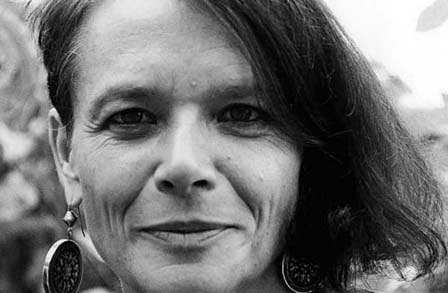I’ve read Anne Waldman since 2001 (Fast Speaking Woman: Chants and Essays got me started). Her epics, poems, interviews, and edited anthologies (from the Kerouac School at Naropa) stimulate and open up possibilities. One of her most engaging books is OUTRIDER: Poems, Essays, Interviews. For you, friends in the writing sangha, I offer the following passages: May one or more of these be a goad, an encouragement, an invitation.
Worry the essential library. Write what you would want to read. Utopian poetics, what you want to read. 15
A good idea: Contemplative education. Non-competitive education. 17
Maker of books she might be. Maker of schools. 23
Encourage street corner culture. What happens below the radar. 27
Nowhere to go again but the library. 29
To contend, to enliven, to distance, to advocate, to investigate, to rally, to prioritize, to surprise. 31
To vocalize. To mouth the impossible. 31
I have declared in one manifesto, a writing beyond gender, and have tried to inspire a poet’s Bodhisattva Vow, in which one becomes a bridge, a path, a shelter, whatever is required, for others. And one reads and studies and performs… for the benefit of others. 46
One could be trained to help the world. And live one’s life in sane and meaningful ways not based on monetary or worldly gain. A school arming its students with ideas of how to ease the pain of suffering seemed radical in 1974. 48
…an exchange that didn’t need formal parameters but extended, happily, beyond the classroom. 49
That a notion of a community sympathetic to this notion of passing it on exists. That you are not alone in your projective voice, the arena of your various languages and cultures. That you write missives, that you might be on a mission, that you won’t miss anything, that you are active, energetic, that language is imaginative through all the shapes and sizes of itself—trans, bi, straight, polysemous… 54
There is a notion of “passing it on,” that simple. One to one. Elder to younger perhaps. That “poetry is news,” that the inspiration for any work you do and the work you do as a writer and artist connects you to an ageless continuum. “In the mind of the poet, all times are contemporaneous.” 54
“Both, both” is the stance on the charnel ground. You trust your sensibility, and you develop your gifts, which you see as upaya (skillful means) as everything churns in the maw of the Hag. And you paw with it all in the flickering light and shadow. 73
{Engage] in cross-cultural exchanges, crucial translation projects, correspondences … 118
You can force this stuff down people’s throats but there’s a creative gene in everyone’s psyche. They need us reminding them and ourselves. 54
Awake out of your sloth! Get your life in gear! We DON’T want to be speaking the language of Empire, of Auschwitz. 54
Pratitya samutpada—Sanskrit for the co-inter-active interdependency of our existence and beyond—seems to invite a hybrid agenda for empathy and co-existence? Yet falters in the arrogance and prioritizing of the human or the privileged human life style… 56
Ernesto Cardenal advocates “exteriorismo”—not unlike the strategy of Investigative Poetics where you bring exact data, information, and elements of real life into the work. 58
Hybrid forms include performance—words with music, dance, gesture, all manner of transformation. 58
Hybrid forms include the blurring of distinctions between prose and poetry. Harryette Mullen, Renee Gladman, Bhanu Kapil. Between life and dream. The look is different on the page. 58
Poetry and essay. Non-narrative prose intervention. 58
Inter-textuality—the Rhizomic possibilities with computer technology. Word, image, sound, duration… 59
The visual—the pictures—photos in the work of Sebold the novelist, in recent book length texts (Claudia Rankine, just one example), the way Susan Howe draws on marginalia in Melville’s Marginalia. 59
We need witness collectives. We need to “tithe our time,” never again, this madness against the body, OUTRIDER citizens, not again, never again. Each individual case. Not the proper care, mis-diagnosis, all-out harm. 60
We need to investigate and document relevant information and stay on it, go through the courts, work with like-minded compassionate warriors of Change. 61
The public obligation requires a certain consistency that you, as poet citizen, can be relied on to serve. Serve the art. Serve the community. 77
Why wait around to get published by an uptown publisher? There’s an isolation in that process, constant hope and fear. 83
One might argue that, in its informality and inclusivity, it’s a journal, a journal poetics. Or one might say that, through its lack of a mastering “center,” it enables a new kind of chromosomal hybridity… 90
Poets need to keep a fluidity with their “cultural interventions,” in their role as interlocutors, archeologists of morning, of perpetual inquiry. 123
[Ginsberg’s HOWL] was a cri de coeur, an alarm, a vision. Its structure matched its energy which seemed the voices of many, not one. It was a rhizomic collage, just like life, a pastiche of the experience of many others, encompassing flashes of “minute particulars.” 179
Surrealist, cut-up, dream, documentation, aleatory strategies all played in here. 179
The magnanimity of [HOWL’s] reach never ceases. Its anaphoric “who,” its lists of minute particulars, reverberate through time. It is a time machine, it is also a time bomb. It carries warning, prophecy. The desire of “eternal spring of feeling,” its aspiration, is what drives its persistent existence. 182
Photo from here
